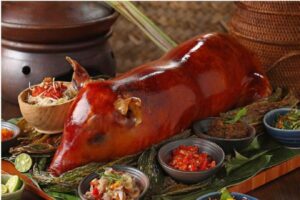To discover the true heart of Balinese cuisine, you must explore the wonderful world of Bali warungs. These are the humble, often family-run eateries. They serve up the island’s most authentic, delicious, and affordable food. While Bali boasts world-class fine dining, it’s in these simple establishments that the soul of local cooking truly thrives. This is where Balinese families eat. Here, recipes pass down through generations. You’ll find flavors you’ll dream about long after your holiday is over.
For a first-time visitor, stepping into a busy local warung might feel a little intimidating. But fear not! It’s a rewarding adventure. Furthermore, it’s easier to navigate than you think. As your friendly guides here at Merusaka Nusa Dua, we want to give you the confidence to dive in. This ultimate guide will explain what a warung is. It also shares how to choose a great one. You’ll learn what delicious types of food you can expect to find among Bali warungs.
What Exactly is a Warung?
Before we begin our culinary tour, let’s understand what we’re looking for. A “warung” is a broad term in Indonesia. It refers to a small, often family-owned business. In the context of food, it can range from a simple roadside food stall or a cart (kaki lima) to a more established small, casual restaurant.
The vibe is typically unpretentious, friendly, and focused on one thing: serving good, honest, and incredibly tasty food. It’s the opposite of a formal restaurant. Instead, it’s all about the flavor and the local experience. This casual approach is a key characteristic of Bali warungs.
How to Spot a Great Warung: The Three Golden Rules
With so many options, choosing a warung can be part of the fun. You don’t always need online reviews. Instead, you just need to use your eyes and your intuition. Here are a few simple tips to help you find a gem among Bali warungs.
Look for the Crowds (Especially Locals!)
This is the single best indicator of quality. If a warung is busy, it’s almost certainly a winner. Look for local residents, office workers on their lunch break, or a steady stream of Gojek drivers picking up orders. A high turnover means the food is fresh, trusted, and delicious. Busy Bali warungs are often the best!
Observe the Cleanliness
While warungs are simple, a good one will be tidy. Look for clean tables. Check for a well-kept food display case. There should also be a general sense of order. This shows attention to detail, even in casual Bali warungs.
They Often Specialize
Many of the very best Bali warungs become famous for perfecting just one or two dishes. If you see a sign that only mentions “Babi Guling” or “Sate,” you can be sure they take that specific dish very seriously. This specialization often guarantees exceptional quality.
A Guide to Different Types of Warungs
Not all Bali warungs serve the same thing! Many focus on a particular style of dish. This offers a unique culinary experience. Here are a few key types to look out for on your adventure.
The Warung Nasi Campur (The “Point and Choose” Adventure)
This is the most common, and perhaps the most fun, type of warung for a food lover. “Nasi Campur” simply means “mixed rice.” The experience involves a large glass display case. It’s filled with a dazzling array of 15, 20, or even more different freshly cooked dishes. You start with a plate of steamed rice (nasi putih). Then, you simply point (tunjuk) to the various delicious-looking dishes you want to add. It’s a fantastic way to sample many different flavors at once! Common dishes you might see include grilled chicken (ayam bakar), various vegetable preparations (urap or lawar), fried tofu and tempeh, beef rendang, grilled fish, fried noodles, and of course, a variety of spicy, flavorful sambal. Many Bali warungs offer this exciting option.
The Warung Babi Guling (The Famous Suckling Pig)
 This type of warung specializes in Bali’s most famous ceremonial dish: Babi Guling. This is a whole pig. Locals stuff and marinate it with a rich blend of Balinese spices (basa gede). Then, they slowly spit-roast it over a fire for hours. The meat becomes succulent, and the skin turns incredibly crispy. A standard portion is served with rice. It typically includes tender meat, a coveted piece of crispy skin, blood sausage, and some spicy vegetables. It’s a true Balinese delicacy. Finding a dedicated Bali warung for Babi Guling is a real treat!
This type of warung specializes in Bali’s most famous ceremonial dish: Babi Guling. This is a whole pig. Locals stuff and marinate it with a rich blend of Balinese spices (basa gede). Then, they slowly spit-roast it over a fire for hours. The meat becomes succulent, and the skin turns incredibly crispy. A standard portion is served with rice. It typically includes tender meat, a coveted piece of crispy skin, blood sausage, and some spicy vegetables. It’s a true Balinese delicacy. Finding a dedicated Bali warung for Babi Guling is a real treat!
The Warung Sate (Grilled to Perfection)
 You can often smell these wonderful stalls before you see them. This is thanks to the fragrant smoke from their charcoal grills. These Bali warungs specialize in satay. You’ll find the internationally famous Sate Ayam (chicken satay served with a rich peanut sauce) as well as the uniquely Balinese Sate Lilit. Sate Lilit is made from minced meat (often fish, chicken, or pork). Locals blend it with grated coconut and spices. Then, they “wrap” or “coil” (lilit) it around a skewer. This is often a flattened bamboo stick or a lemongrass stalk. Finally, it’s grilled.
You can often smell these wonderful stalls before you see them. This is thanks to the fragrant smoke from their charcoal grills. These Bali warungs specialize in satay. You’ll find the internationally famous Sate Ayam (chicken satay served with a rich peanut sauce) as well as the uniquely Balinese Sate Lilit. Sate Lilit is made from minced meat (often fish, chicken, or pork). Locals blend it with grated coconut and spices. Then, they “wrap” or “coil” (lilit) it around a skewer. This is often a flattened bamboo stick or a lemongrass stalk. Finally, it’s grilled.
The Warung Bakso or Mie Ayam (The Comfort Food Cart)
These are the beloved mobile food carts and simple stalls. You’ll see them all over Bali. They serve up Indonesia’s favorite comfort foods. Bakso is a hearty meatball soup, often served with noodles and tofu. Meanwhile, Mie Ayam is a delicious bowl of chicken noodles. They are a quick, satisfying, and authentically local meal. Everyone enjoys them. These common Bali warungs offer quick and tasty bites.
Warung Etiquette & Practical Tips
Eating at a warung is a casual and relaxed experience. However, knowing a few small customs can make it even smoother and more enjoyable. These tips apply to most Bali warungs.
Ordering Your Meal
For Nasi Campur, the “point and choose” method is standard. For specialty warungs, you usually just order a “portion” (satu porsi).
Dining Customs
Most Bali warungs provide a fork and spoon. It’s customary to eat with the spoon in your right hand. Use the fork in your left hand to push food onto the spoon. If you happen to be in a situation where eating with your hands is the norm, remember to only use your right hand. This is because locals consider the left hand impure.
Payment
Payment is almost always made at the very end of your meal. You usually pay at a central cashier counter. Cash is essential! Very few small, local Bali warungs accept credit cards. So, be sure to have Indonesian Rupiah (IDR) with you.
Tipping
Tipping is generally not expected at these small, local eateries. However, if you’ve had a wonderful meal and great service, leaving the small change or rounding up your bill is always a kind and appreciated gesture.
Conclusion: Your Most Authentic Meal Awaits
Exploring Bali warungs is your key to discovering the island’s authentic culinary soul. It’s an invitation to step away from the main tourist restaurants. Instead, you get to eat where the locals eat. Be adventurous, follow the crowds, and prepare to have some of the most delicious, memorable, and affordable meals of your trip.
Even with all the wonderful fine dining available at a sophisticated resort like Merusaka Nusa Dua, we believe the simple joy of a fantastic warung meal is a cherished part of the complete Bali experience. Enjoy your delicious adventure!



